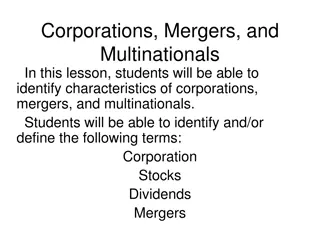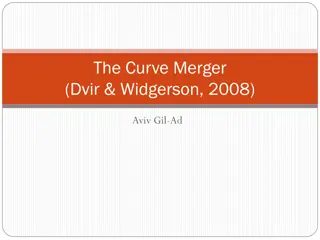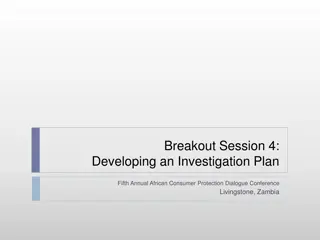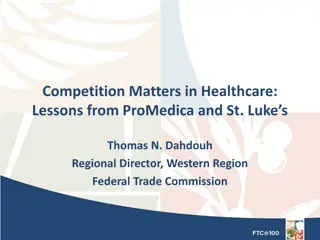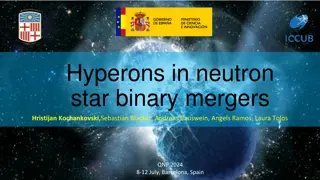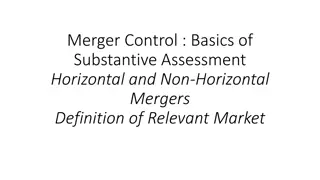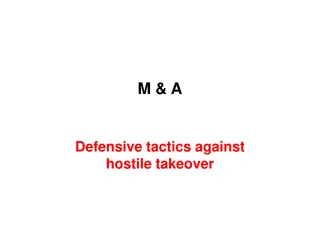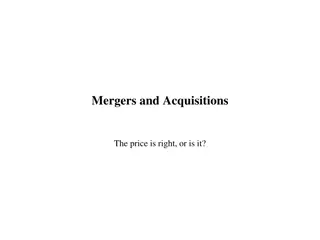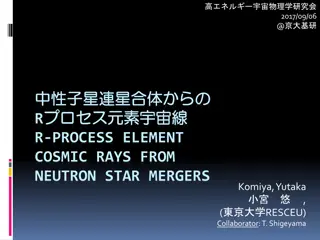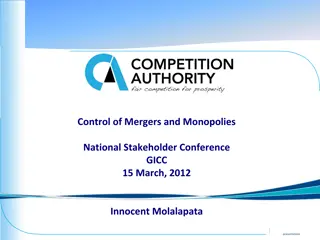Implications of Mergers in Higher Education
Various forms of relationships in the English higher education sector, including mergers, are explored in this research paper. It delves into the reasons for mergers, previous evidence on their consequences, measuring efficiency, and key results from related studies. The aim is to understand how mergers impact efficiency in higher education institutions.
Download Presentation

Please find below an Image/Link to download the presentation.
The content on the website is provided AS IS for your information and personal use only. It may not be sold, licensed, or shared on other websites without obtaining consent from the author.If you encounter any issues during the download, it is possible that the publisher has removed the file from their server.
You are allowed to download the files provided on this website for personal or commercial use, subject to the condition that they are used lawfully. All files are the property of their respective owners.
The content on the website is provided AS IS for your information and personal use only. It may not be sold, licensed, or shared on other websites without obtaining consent from the author.
E N D
Presentation Transcript
Centre for Global Higher Education UCL Institute of Education 29thSeptember 2016 MERGERS IN HIGHER EDUCATION: IMPLICATIONS FOR EFFICIENCY Jill Johnes University of Huddersfield
Outline of talk Introduction Background Reasons for merger in higher education Previous evidence on the consequences of mergers Measuring efficiency a brief overview Summary of results from 3 papers Conclusions
Introduction Various forms of relationships can be observed in the English higher education (HE) sector: shared purchasing and services joint ventures and alliances full merger This paper is concerned only with merger: Merger: two or more partners combining to create a single institution, which may retain the name and legal status of one of them or be an entirely new legal entity. (HEFCE 2012, p11)
Introduction The current economic climate puts pressure on publicly-funded sectors to deliver more for less including English HE Funding cuts can be absorbed by efficiency savings possibly achieved by mergers(the efficiency theory) If institutional failure cannot be prevented , then the Council will explore options such as mergers or takeovers led by other providers so that the institution in a new form becomes a going concern. (The Browne Report 2010 p46) Throughout the world concentration of research funding is the name of the game,... How can you possibly compete as a single institution? (Professor Sir Steve Smith, vice-chancellor of Exeter University, reported in The Guardian 16th October 2012) Sir Roderick Floud former president of Universities UK believes that the number of universities in the UK should be cut by at least one-third if not one-half (THE 19-25 June 2014)
Introduction Some questions: Does the merger of 2 (or more) HEIs cause an increase in subsequent efficiency? Do the efficiency effects of merger take time to reap?
Introduction Some problems: Measuring efficiency Comparatively few mergers in English higher education Merger activity and efficiency may be endogenous i.e. merger leads to efficiency, but the existence of inefficiency may lead to merger. Conventional econometric techniques of analysis may not be appropriate
Background Mergers in English HE Mergers in English HE have varied in HEI composition They have largely been HEI-motivated This contrasts with the experience in other countries eg. Wales: The Welsh government has stepped in to reduce the number of universities in Wales; maybe the English government will have to do the same. experience suggests that universities [in England] will not make such radical changes for themselves Sir Roderick Floud, THE 19-25 June 2014
Background The future? Boxall and Woodgates (2014)
Reasons for merger in HE 1. Efficiency theory A merger will occur if the merging HEIs believe they can be run more efficiently and effectively together than separately Economies of scale (Fielden and Markham 1997; Skodvin 1999; Patterson 2000; Kyvik 2002; Norg rd and Skodvin 2002; Teixeira 2007; Green and Johnes 2009) Economies of scope (Patterson 2000; Harman 2000; Harman and Meek 2002; Kyvik 2002; Harman and Harman 2003; Aarrevaara 2007; Teixeira 2007) Prediction: merger leads to lower inefficiency
Reasons for merger in HE 2. Strategy motive A merger will occur for reasons of survival and/or growth for at least one of the participants (Pritchard 1993; Rowley 1997; Harman and Meek 2002; Harman and Harman 2003) Prediction: inefficiency leads to merger
Reasons for merger in HE Strategy motive (continued) A merger will occur to enhance reputation (Skodvin 1999; Engwall 2007; Harman and Harman 2008; Tirronenen and Nokkala 2009; Aula and Tienari 2011) A merger will occur to improve international competitiveness (Mok 2005; Tirronenen and Nokkala 2009) Prediction: merger leads to lower inefficiency
Reasons for merger in HE Evidence in the UK HE context Efficiency theory is the main underlying cause of merger activity in GB (Rowley 1997) Economies of scale: - are just exhausted for the typical HEI (Johnes 1997; Izadi et al 2002; Johnes et al 2005; Johnes et al 2008; Johnes and Johnes 2009 ) Economies of scope - are just exhausted or decreasing for the typical HEI (Glass et al 1995a; 1995b; Johnes 1997; Izadi et al 2002; Johnes et al 2005; Johnes et al 2008; Johnes and Johnes 2009)
Reasons for merger in HE Evidence in the UK HE context Boxall, M. and P. Woodgates (2014).
Reasons for merger in HE Evidence in the UK HE context Successive studies of higher education in Wales conclude that, in the face of global competition and increasing marketisation, the sector will need to address its inherent weaknesses of fragmentation and lack of scale, tackle issues surrounding new forms of delivery, and markedly improve its research performance and financial resilience. Department for Children Education Lifelong Learning and Skills (Wales) (2011).
Reasons for merger in HE Evidence in the UK HE context Successive studies of higher education in Wales conclude that, in the face of global competition and increasing marketisation, the sector will need to address its inherent weaknesses of fragmentation and lack of scale, tackle issues surrounding new forms of delivery, and markedly improve its research performance and financial resilience. Department for Children Education Lifelong Learning and Skills (Wales) (2011).
Previous evidence Case studies: Failure rate of HE mergers is 10% (Rowley 1997) compared to 25 to 50% in private sector (HEFCE 2012) Mergers are successful in the context of non-viable HEIs (Harman & Harman 2003) Mergers are more successful if they are geographically close (Skodvin 1999) Mergers undertaken for academic reasons may not reap rewards in terms of efficiency (Skodvin 1999)
Previous evidence Statistical analyses: China (Mao 2009): efficiency and outcomes improved in year following merger; but did not in the second year China (Hu & Liang 2008): large rise in mean productivity in merger HEIs in year following merger, but a fall the second year after merger
Previous evidence Statistical analyses: some caveats - Previous statistical analyses fail to take into account the complex relationship between inefficiency and merger that other underlying characteristics might cause merging institutions to perform differently from non- merging ones - Any measurement of efficiency typically does not incorporate any loss caused by the merger in learning experience on the part of students or staff does not incorporate any social costs arising from reduction in diversity between HEIs in the sector or regional effects of HEIs
Measuring efficiency Research/staff Production possibility frontier (PPF) Teaching/staff O
Measuring efficiency Research/staff Efficiency = OF/OF Thus: Estimation of the PPF is needed to produce estimates of efficiency F F Teaching/staff O
Measuring efficiency Data envelopment analysis (DEA) Charnes, Cooper & Rhodes(1978) DEA estimates a piecewise linear frontier using linear programming methods No error term; no equation
2. Efficiency and its measurement Ordinary least squares regression Research/staff F F Teaching/staff O
Measuring efficiency Stochastic frontier analysis (SFA) Aigner, Lovell and Schmidt (1977) The error term is split into 2 components: - a random error component (as in OLS) - a half-normally distributed component to reflect efficiency
2. Efficiency and its measurement Ordinary least squares regression Research/staff F F Teaching/staff O
Measuring efficiency Inputs and outputs Inputs Outputs Teaching: Primary inputs: PGINPUT (x1): Numbers on postgraduate programmes UGINPUT (x2): Numbers on undergraduate programmes PGOUTPUT (y1): Graduates from postgraduate programmes UGOUTPUT (y3): Graduates from undergraduate programmes Black Box Labour: STAFF (x3): Number of FTE academic staff ADMIN (x5): Expenditure on administration including staff Research: RESEARCH (y2): Income received in funding council grants plus income received in research grants and contracts Capital: ACSERV (x4): Expenditure on library and computing facilities
Summary of results 1: Johnes 2014 Panel of data from 1996/97 to 2008/09 with n = 1444 total observations (the number of HEIs varies from 108 to 113 in each year) Data from Higher Education Statistical Agency (HESA) All money units in 2008 values 19 mergers in the data set Various efficiency estimation methods (DEA and SFA) Merger effects explored using a simple comparison of mean efficiency by pre-, post- and non-merging HEIs
Summary of results 1: Johnes 2014 4500 4000 3500 3000 Pre-merging HEIs 2500 Post-merging HEIs 2000 Non-merging HEIs 1500 1000 500 0 PGOUTPUT UGOUTPUT UGOUTQUAL RESEARCH
Data 35000 30000 25000 20000 Pre-merging HEIs Post-merging HEIs 15000 Non-merging HEIs 10000 5000 0 PGINPUT UGINPUT UGINQUAL STAFF ACSERV ADMIN
Summary of results 1: Johnes 2014 The typical HEI involved in a merger has efficiency which is similar to the average non-merging HEI The typical merged HEI is significantly more efficient than either pre-merger or non-merging HEIs Caveats The two-way relationship between merger and efficiency is not explored The characteristics of pre-, post- and non-merging HEIs differ; any efficiency differences may be a consequence of something other than the merger Effects of merger can vary by the types of HEI participating in the merger; there are both winners and losers in the merging process
Summary of results 2: Johnes and Papadimitriou 2016 Panel of data from 1996/97 to 2012/13 with n = 2197 total observations (the number of HEIs varies from 125 to 138 in each year) Data from Higher Education Statistical Agency (HESA) All money units in 2012 values 28 mergers in the data set DEA used to measure efficiency Merger effects explored using a second stage model regressing efficiency on a variety of possible explanatory variables including whether or not a HEI merged
Summary of results 2: Johnes and Papadimitriou 2016 Mean DEA efficiency over time 0.750 0.700 Mean Efficiency 0.650 0.600 0.550 0.500 Bias Corrected Efficiency_CRS
Summary of results 2: Johnes and Papadimitriou 2016 Efficiency of merged HEIs is significantly higher than that of non-merged (taking into account a whole array of other characteristics of the HEIs) The efficiency effects seem to occur 1 and 2 years after the merger but are not observed afterwards Caveats The two-way relationship between merger and efficiency is not explored
Summary of results 3: Johnes and Tsionas 2016 Panel of data from 1996/97 to 2008/09 with n = 1694 (the number of HEIs varies from 126 to 138 in each year) All money units in 2008 values Data from Higher Education Statistical Agency (HESA) 25 mergers Uses SFA to estimate efficiency Uses a complex model which takes into account the endogeneity (two-way relationship) between merger activity and efficiency
Summary of results 3: Johnes and Tsionas 2016
Summary of results 3: Johnes and Tsionas 2016 But the overlapping of the distributions suggests that efficiency improvement is not unambiguous. In fact Of 25 mergers, 11 have a less than 70% probability that efficiency will improve
Summary of results 3: Johnes and Tsionas 2016 What are the characteristics of a successful merger? Geography (Skodvin 1999)? An examination of the distance between merging HEIs reveals no particular patterns Similar culture and mission (HEFCE 2010)? Possibly not: Of the 11 mergers which have probability of efficiency improvement < 70%, 6 are between HEIs of the same type Grants from HEFCE s Strategic Development Fund (now called the Catalyst Fund)? For example: the Manchester merger attracted a grant of 10 million plus a further 10 million in repayable grants
Summary of results 3: Johnes and Tsionas 2016
Conclusions Merging HEIs are typically more efficient than pre- and non-merging HEIs (Johnes, 2014; Johnes & Tsionas, 2016; Johnes & Papadimitriou, 2016) Efficiency improvement is not experienced across all mergers (Johnes, 2014; Johnes & Tsionas, 2016) The benefits of merger are probably experienced sooner rather than later (Johnes & Papadimitriou, 2016; Johnes & Tsionas 2016) The reasons for differences between mergers and over time should be explored further
Conclusions Caveats efficiency doesn t measure: loss imposed by the merger in terms of learning (and teaching) experience on the part of students (or staff) possible social costs arising from reduction in diversity between HEIs in the sector caused by merging regional economic effects of HEI closures




